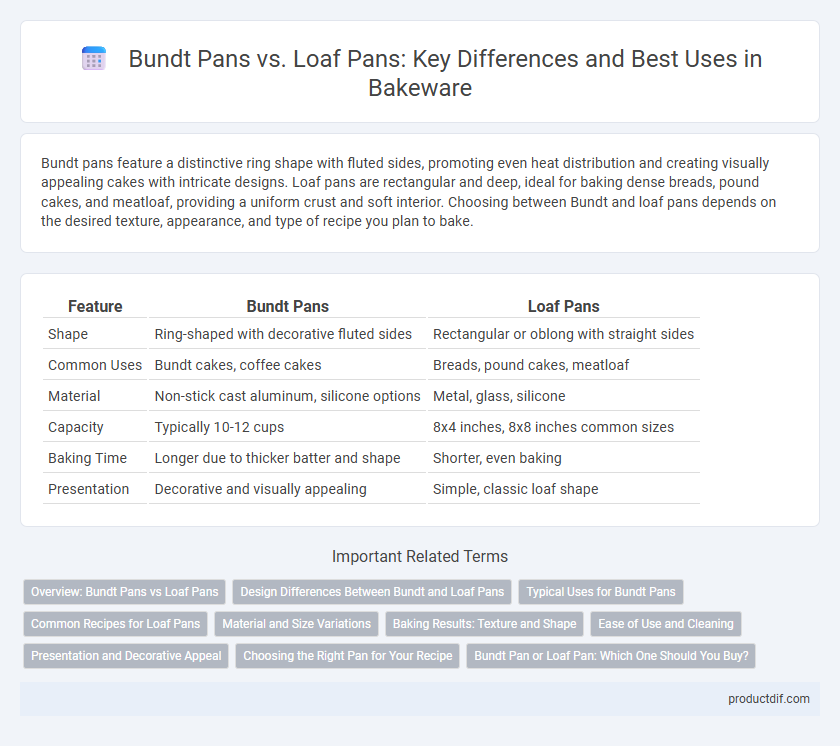Bundt pans feature a distinctive ring shape with fluted sides, promoting even heat distribution and creating visually appealing cakes with intricate designs. Loaf pans are rectangular and deep, ideal for baking dense breads, pound cakes, and meatloaf, providing a uniform crust and soft interior. Choosing between Bundt and loaf pans depends on the desired texture, appearance, and type of recipe you plan to bake.
Table of Comparison
| Feature | Bundt Pans | Loaf Pans |
|---|---|---|
| Shape | Ring-shaped with decorative fluted sides | Rectangular or oblong with straight sides |
| Common Uses | Bundt cakes, coffee cakes | Breads, pound cakes, meatloaf |
| Material | Non-stick cast aluminum, silicone options | Metal, glass, silicone |
| Capacity | Typically 10-12 cups | 8x4 inches, 8x8 inches common sizes |
| Baking Time | Longer due to thicker batter and shape | Shorter, even baking |
| Presentation | Decorative and visually appealing | Simple, classic loaf shape |
Overview: Bundt Pans vs Loaf Pans
Bundt pans feature a distinctive ring shape with fluted sides, ideal for evenly baked, decorative cakes with intricate designs, while loaf pans offer a rectangular form perfect for bread, pound cakes, and meatloaf with straight edges for uniform slices. Bundt pans typically have nonstick coatings and a central tube ensuring efficient heat distribution, whereas loaf pans vary in materials like metal, glass, or silicone, affecting heat conduction and baking results. Choosing between Bundt and loaf pans depends on the baked goods' desired texture, shape, and presentation requirements.
Design Differences Between Bundt and Loaf Pans
Bundt pans feature intricate, fluted designs with a central tube that promotes even heat distribution and creates decorative cakes, while loaf pans have a simple rectangular shape ideal for uniform, dense breads and meatloaves. The Bundt pan's hollow center helps bake thick batters evenly by allowing heat to reach the middle, contrasting with the straightforward depth and straight sides of loaf pans that support rising dough. These design differences impact baking outcomes, with Bundt pans suited for ornate desserts and loaf pans better for traditional bread textures and shapes.
Typical Uses for Bundt Pans
Bundt pans are ideal for creating intricately shaped cakes, such as classic Bundt cakes and pound cakes, that showcase decorative patterns and textures. Their design promotes even baking and an attractive crust, making them perfect for dense, buttery desserts often topped with glazes or powdered sugar. Unlike loaf pans, Bundt pans are rarely used for bread or savory dishes, emphasizing their specialty in elegant, visually stunning sweet treats.
Common Recipes for Loaf Pans
Loaf pans are commonly used for baking classic recipes such as banana bread, zucchini bread, and meatloaf, providing a uniform shape and even cooking. Their straight sides allow for easy slicing and consistent texture throughout the loaf. This versatility makes loaf pans ideal for both sweet and savory baked goods, ensuring perfect results for dense batter or dough recipes.
Material and Size Variations
Bundt pans are typically made from heavy cast aluminum or non-stick coated steel, which ensures even heat distribution for intricate designs, while loaf pans come in materials like aluminum, stainless steel, silicone, or glass, offering versatility for different baking needs. Bundt pans are usually larger, with capacities ranging from 10 to 15 cups, producing dense, decorative cakes, whereas loaf pans have smaller capacities between 6 to 8 cups, ideal for bread and smaller cakes. Size variations in both pans significantly impact baking times and texture, making material and size essential factors in choosing the right bakeware for specific recipes.
Baking Results: Texture and Shape
Bundt pans create cakes with a moist, dense texture and intricate, decorative shapes due to their fluted sides and central tube, which also ensures even heat distribution. Loaf pans produce uniform, rectangular breads or cakes with a tighter crumb and a crisp crust, ideal for sandwiches and sliced servings. The choice between Bundt and loaf pans significantly affects the final product's texture, shape, and presentation in bakeware.
Ease of Use and Cleaning
Bundt pans feature intricate designs that can make cleaning more challenging due to hard-to-reach crevices, while their nonstick coatings often aid in easier release of baked goods. Loaf pans offer a straightforward rectangular shape that simplifies both batter pouring and cleaning, making them more user-friendly for everyday baking tasks. Choosing between the two depends on balancing the desired cake presentation with the practicality of maintenance and ease of use.
Presentation and Decorative Appeal
Bundt pans create visually striking cakes with intricate patterns and fluted designs, making them ideal for special occasions and elegant presentations. Loaf pans produce simple, rectangular shapes that emphasize rustic charm and classic appeal, often suited for everyday serving and slicing. The decorative appeal of Bundt cakes generally surpasses that of loaf breads, enhancing table aesthetics and guest impression.
Choosing the Right Pan for Your Recipe
Bundt pans feature fluted sides and a hollow center, promoting even heat distribution and creating visually striking cakes, ideal for dense, moist recipes like pound cakes. Loaf pans are rectangular with straight sides, perfect for bread, meatloaf, and quick breads that require uniform shape and structure. Selecting the right pan depends on the desired texture and presentation, with Bundt pans enhancing decorative detail and loaf pans ensuring consistent internal crumb.
Bundt Pan or Loaf Pan: Which One Should You Buy?
Bundt pans are ideal for creating visually striking cakes with intricate designs and even baking due to their ring shape and fluted sides, which also help with heat distribution. Loaf pans are better suited for denser, bread-like recipes such as banana bread or meatloaf, providing straight sides for easy slicing and uniform shapes. Choosing between a Bundt pan and a loaf pan depends on whether you prioritize decorative presentation or versatility in baking breads and compact cakes.
Bundt pans vs loaf pans Infographic

 productdif.com
productdif.com